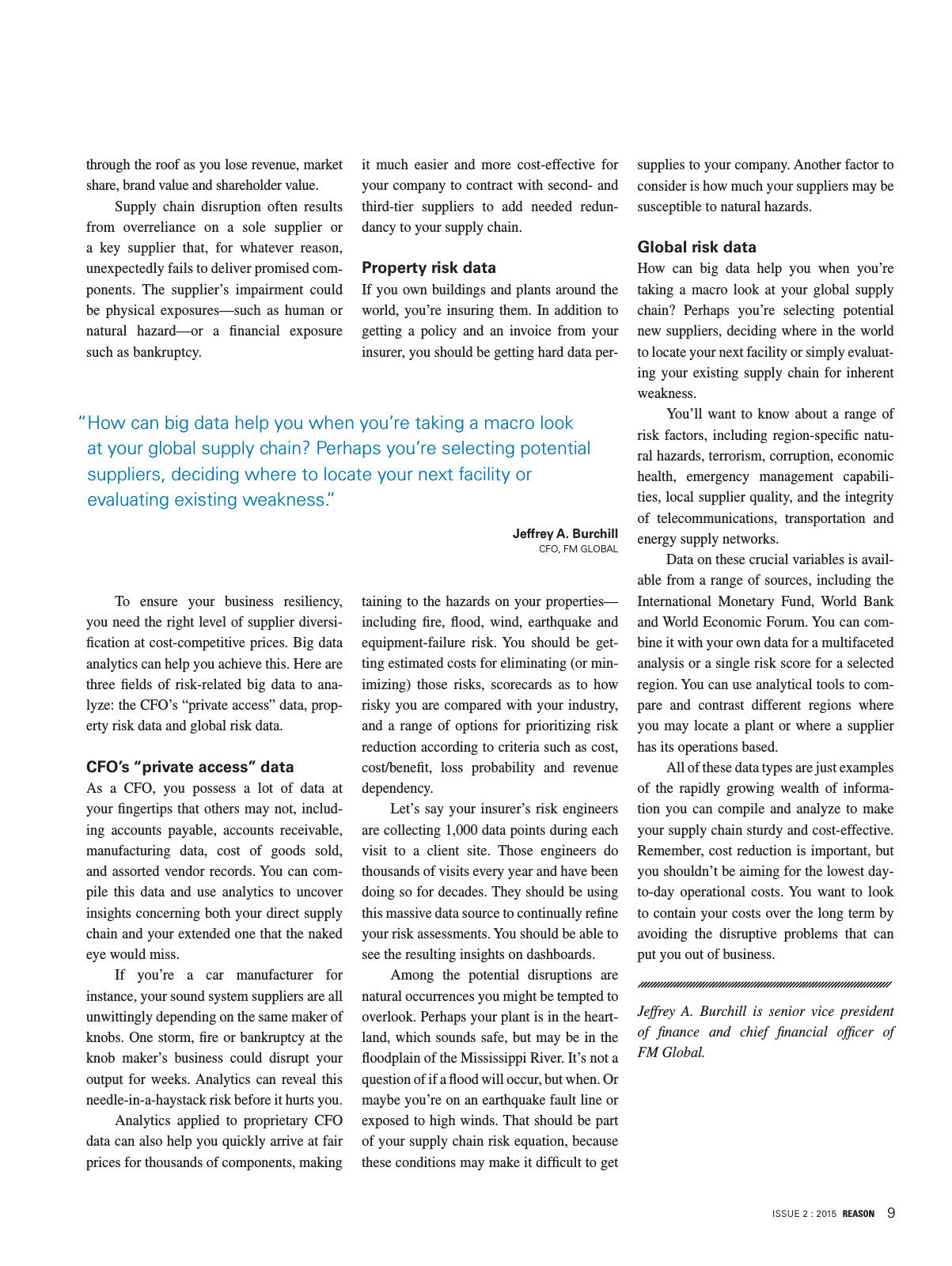supplies to your company Another factor to consider is how much your suppliers may be susceptible to natural hazards Global risk data How can big data help you when you re taking a macro look at your global supply chain Perhaps you re selecting potential new suppliers deciding where in the world to locate your next facility or simply evaluat ing your existing supply chain for inherent weakness You ll want to know about a range of risk factors including region specific natu ral hazards terrorism corruption economic health emergency management capabili ties local supplier quality and the integrity of telecommunications transportation and energy supply networks Data on these crucial variables is avail able from a range of sources including the International Monetary Fund World Bank and World Economic Forum You can com bine it with your own data for a multifaceted analysis or a single risk score for a selected region You can use analytical tools to com pare and contrast different regions where you may locate a plant or where a supplier has its operations based All of these data types are just examples of the rapidly growing wealth of informa tion you can compile and analyze to make your supply chain sturdy and cost effective Remember cost reduction is important but you shouldn t be aiming for the lowest day to day operational costs You want to look to contain your costs over the long term by avoiding the disruptive problems that can put you out of business it much easier and more cost effective for your company to contract with second and third tier suppliers to add needed redun dancy to your supply chain Property risk data If you own buildings and plants around the world you re insuring them In addition to getting a policy and an invoice from your insurer you should be getting hard data per taining to the hazards on your properties including fire flood wind earthquake and equipment failure risk You should be get ting estimated costs for eliminating or min imizing those risks scorecards as to how risky you are compared with your industry and a range of options for prioritizing risk reduction according to criteria such as cost cost benefit loss probability and revenue dependency Let s say your insurer s risk engineers are collecting 1 000 data points during each visit to a client site Those engineers do thousands of visits every year and have been doing so for decades They should be using this massive data source to continually refine your risk assessments You should be able to see the resulting insights on dashboards Among the potential disruptions are natural occurrences you might be tempted to overlook Perhaps your plant is in the heart land which sounds safe but may be in the floodplain of the Mississippi River It s not a question of if a flood will occur but when Or maybe you re on an earthquake fault line or exposed to high winds That should be part of your supply chain risk equation because these conditions may make it difficult to get through the roof as you lose revenue market share brand value and shareholder value Supply chain disruption often results from overreliance on a sole supplier or a key supplier that for whatever reason unexpectedly fails to deliver promised com ponents The supplier s impairment could be physical exposures such as human or natural hazard or a financial exposure such as bankruptcy To ensure your business resiliency you need the right level of supplier diversi fication at cost competitive prices Big data analytics can help you achieve this Here are three fields of risk related big data to ana lyze the CFO s private access data prop erty risk data and global risk data CFO s private access data As a CFO you possess a lot of data at your fingertips that others may not includ ing accounts payable accounts receivable manufacturing data cost of goods sold and assorted vendor records You can com pile this data and use analytics to uncover insights concerning both your direct supply chain and your extended one that the naked eye would miss If you re a car manufacturer for instance your sound system suppliers are all unwittingly depending on the same maker of knobs One storm fire or bankruptcy at the knob maker s business could disrupt your output for weeks Analytics can reveal this needle in a haystack risk before it hurts you Analytics applied to proprietary CFO data can also help you quickly arrive at fair prices for thousands of components making How can big data help you when you re taking a macro look at your global supply chain Perhaps you re selecting potential suppliers deciding where to locate your next facility or evaluating existing weakness Jeffrey A Burchill CFO FM GLOBAL Jeffrey A Burchill is senior vice president of finance and chief financial officer of FM Global ISSUE 2 2015 REASON 9

Hinweis: Dies ist eine maschinenlesbare No-Flash Ansicht.
Klicken Sie hier um zur Online-Version zu gelangen.
Klicken Sie hier um zur Online-Version zu gelangen.